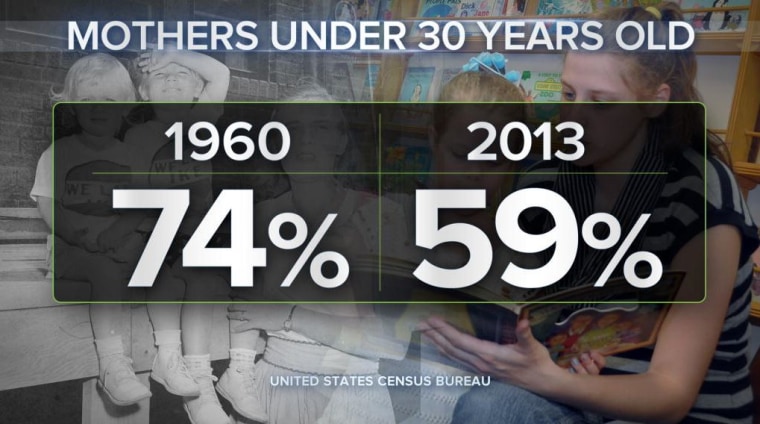The traditions of Mother’s Day weekend are tried and true: brunch, cards, flowers. But mothers themselves? They have changed a lot in the last 50 years and through those changes you can see the outlines of broader shifts that have remade the country in that time.
Comparing today to 1960, moms are, for the most part, a little older than they used to be and lot better educated. But they are overseeing smaller families and more likely to be flying solo as parents.
The numbers reveal one other point. There may be more mothers in the workforce than ever, but they earn less than fathers, by large margins in some cases.
In 1960, 48% of children were born to mothers 24 years old or younger, according to Census data. And only 26% were born to mothers older than 30.
By 2013 only 30% were born to mothers 24 or younger. Meanwhile 41% of all the children were born to parents 30 or older.

You can see all the age ranges on this chart. The biggest percentage point drop came in mothers giving birth in the 20- to 24-year-old age range.
That shift to older moms is likely directly tied to an enormous jump in education among mothers over the past 50 years – balancing school and a newborn is no easy task. Back in 1960 only 18% of mothers had spent some time in college, according to a Pew Research Center analysis of Census data. Today that figure is over 60% according to data from the Census.
That’s a remarkable tripling in that figure over that time.
Older and better-educated moms are fundamentally different from their predecessors. Their education means they have more opportunities outside the home if that’s a path they choose to follow.
And economics have played a role in their choosing a path that leads outside the home, as it is harder for families to make it on one income. The single-breadwinner/homemaker family is a dying breed in the United States. Only about quarter of mothers today are “stay at home” moms. That figure was 44% in 1969.
One result of this new social and economic reality is fewer children per family. In 1960, there was an average of 2.3 children under the age of 18 per U.S. family. In 2013, that number is now 1.9 under-18 children per U.S. family.
And all these changes – older, better educated moms who work outside the home with fewer children to care for – have combined with broader social trends (rising divorce rates and more out-of-wedlock births), and led to a sharp increase in the number of single moms, those raising a child under 18 with no husband present. About 8% of children were raised in such homes in 1960, today about 21% are.
Add it all up and it suggests the moms of today have a pretty full plate. In many ways more full than that of the moms of 50 years ago. But in the workplace, the numbers suggest, it’s still better to be a dad.
The wage gap between men and women grows some when the groups being measured are father and mothers. Data from the Bureau of Labor Statistics shows that married men who work full-time salaried positions had average weekly earnings of $981 in 2012; married women who work full-time salaried jobs had average weekly earnings of $751.
Add in children over the age of 6 and the split grows. With children between age 6 and 17 at home, full-time fathers earn an average weekly wage of $1,035, while full-time mothers earn $746.
You can the differences in pay for a range of parenting situations on this chart.
There are a number of possible reasons for those differences –those moms and dads hold different jobs and possibly different kinds of jobs – but they are significant. Over the course of a year the numbers can add up to $5,000 to $10,000.
So by most measures mom is busier than she used to be. She’s a little older and a lot better educated and she’s juggling responsibilities at the office and at home. Those are all reasons to celebrate her on Sunday but beyond the flowers and cards and phone calls, maybe what she’d really like is a raise.